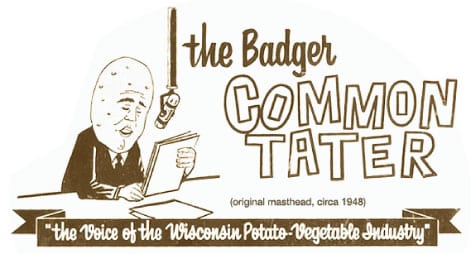
A renowned base-funded researcher specializing in potato and vegetable production and Wisconsin muck potato research, AJ Bussan has worked closely with Central Sands growers for several years to improve water conservation in potato and vegetable production and actively participates in the WPVGA’s Water Task Force.
According to Bussan, a native of Wisconsin, “Central Wisconsin farmers are doing a better job at growing profitable crops while at the same time making less of a demand on local water supplies.”
Previously employed as a Potato and Vegetable Production Specialist at the University of Wisconsin-Madison, where he served as a faculty member in the Department of Horticulture, Bussan is now the Senior Production Agronomist for Wysocki Produce Farms.
He also was a leading participant on several nationally funded potato research projects, including the U.S. Potato Board’s national chip and fry processing trials. Additionally, Bussan actively conducted research related to reducing the amount of acrylamide in processed potatoes and produced key analysis works at the Wisconsin Potato and Vegetable Storage Research Facility.
Honored with the WPVGA Researcher of the Year not once but three separate times along with the WPVGA Industry Appreciation Award, Bussan is a regular contributor to Badger Common’Tater and a guest speaker at many WPVGA events as well as the annual WPVGA Growers’ Conferences over the years.

In previous press coverage, you stated you believe that Wisconsin potato and vegetable growers are doing a better job at growing profitable crops while simultaneously creating less of a demand on local water supplies. Can you elaborate on that belief further?
Wisconsin potato producers were growing more than 80,000 acres of potatoes when I started working with the industry in December of 2001. Of those potatoes, over 60,000 acres were grown under irrigation in Central Wisconsin.
Wisconsin potato acreage had shrunk to 60,000-65,000 acres per year by the end of the last decade with approximately 50,000 acres being grown in Central Wisconsin, yet total production has averaged nearly 95% of the total production that was produced during the first several years of this century.
Potato seasons have not changed dramatically over the course of the last 15 years so the average ET or water use by a full season potato crop has remained relatively constant on a per acre basis, which is 18” to 22” per year.

Wisconsin potato growers typically need to provide 8” to 10” of irrigation per acre in order to grow a full season crop. The results of the increased yield is that Wisconsin potato growers now grow 95% of the crop they grew in 2001 with 75% of the water that was required or water use efficiency (tons of potatoes/acre inch of water) has increased 126%.
Central Wisconsin potato farmers saw a per acre increase in the amount of green beans that were planted that was consistent with declining volume of potato acres. In other words, for every acre of potatoes that was not grown in the seven Central Wisconsin counties an acre of green beans was planted.
Green beans require between 6.5” and 7” of water per acre to grow a mature crop, which is 60 to 65% less water than the average potato crop requires. Even if green beans were double cropped behind peas or green beans, we would see a 20-30% reduction in water use relative to potatoes.
Furthermore, nitrogen requirements of green beans and peas are lower thereby reducing fertilizer use in these crops compared to potatoes.
Additionally, expanding acreage of irrigated farmland through 2011 suggests most new acres are being planted to sweet corn, which requires 12”to 13” per year to grow. So, not only are potatoes grown with improved water use efficiency, but the crops to which irrigated farm land has been rotated, have an overall lower water requirement than potatoes, conserving between 20-40% more water relative to growing potatoes.

Please recognize these estimates are based on in-season water use patterns and only consider crop evapotranspiration (ET) and not water lost outside of the production season.
What are some of the challenges and concerns you see evolving within the irrigated production regions of Wisconsin, particularly with the current Little Plover River situation and water regulation?
The largest challenge from a regulatory standpoint is the hold up in permit application reviews or denials due to recent judicial ruling requiring evaluating cumulative impacts on surface waters of the state.
Farms are at great risk for economic loss if wells fail over the course of the growing season and cannot be repaired in a timely manner. This may be tolerable over the short term or the next 6 to 12 months, but could have catastrophic consequences over the long-term.
The second largest challenge I see is the unwillingness to identify and implement solutions short of shutting off or putting unacceptable restrictions on irrigation wells. I believe we have plenty of water to accomplish agricultural, tourism, industrial, and community goals, but we need a different approach to thinking about water.
In some cases, we may need to prioritize the use in certain areas of the state and correspondingly manage the water in accordance with that priority. For example, irrigation is being developed in new areas of the state and it may be more appropriate to ensure that new wells only cause minimal or acceptable effects. However, where irrigation is widely developed, we should work to maintain the current systems so that the current production is sustainable and does not cause challenges in new areas of the state.
Finally, I believe models that accurately depict cumulative impacts are necessary toward finding new solutions. The models can be used to test hypothetical solutions and implement them across the landscapes of Central Wisconsin and the rest of the state.
I also believe this will provide opportunities to expand irrigated production into areas with little irrigation and avoid concerns and controversies about future water use in those areas.

How can Wisconsin farmers achieve greater efficiency in crop water management?
Efficiency can be increased by reducing evaporation and maintaining transpiration. Reducing ET will ultimately reduce transpiration, which in turn, reduces carbon assimilation and biomass production in plants. Biomass is required to produce yield so reducing transpiration will undermine the water use efficiency accomplishments described above.
If we reduce transpiration and subsequently reduce yield, than it takes more acres to grow the same volume of crop. A 5% reduction in transpiration at the wrong stage of growth will actually double the volume of water required to grow the same amount of crop. Yet, none of the current pumping restrictions account for any of the seasonal fluctuations in water requirements for the crop.
In contrast, reducing evaporation of water or water loss directly from the soil or plant surface has no impact on yield and is the primary mechanism to improve water use efficiency in irrigated fields of Central Wisconsin.
Little is known about specific mechanisms and approaches with the greatest potential affect, but could include no-till production schemes, cover crops, reduced cultivation and other strategies that decrease the presence of bare soil. Evaporation accounts for 20% to 60% of the water loss from production fields depending on the crops being grown.
What irrigation equipment enhancements have you seen that will help Wisconsin farmers continue to be ‘good stewards’ while meeting increasing yield demands?

Properly working irrigation equipment that applies uniform application of water across the field is a huge requirement. This reduces yield variability and more specifically, under and over application of water in parts of the field that can result in reduced yields and subsequent reductions in water use efficiency.
Variable rate application also has the potential to improve irrigation water efficiency. By taking advantage of greater soil moisture holding capacity that may occur in parts of fields, the same crop yields could be achieved with less irrigation water. While total water use efficiency (tons of crop/acre inch transpired) might be similar, the amount of irrigation water required might be reduced.
Otherwise, strategies that minimize evaporation become critical during certain times of the year. For example, 2012 had many days with low relative humidity and high evaporative demand. Under these cropping conditions we may have appreciable evaporation of irrigation waters. This increases the importance of drop nozzles or other strategies that reduce evaporation.

How have research funding efforts from Wisconsin farmers and groups such as WPVGA, helped to better understand the complexities of crop water use and use water more wisely, thusly producing food with a much smaller carbon footprint than would otherwise be possible?
In my mind, two substantial research efforts have been facilitated through research funding critical towards improving water management under irrigated agriculture. The first is differential water use by crops, which has been known for years and studied by soils, agronomy, horticulture and biological systems engineering faculty, staff and students.
New management approaches evaluating landscape strategies to develop crop rotations in space and time are going to be necessary to promote more water conserving farmscapes. Combining this effort with cumulative impact modeling is at the core of new strategies to minimize impacts of irrigation on ground and surface waters.
The second effort is evaluation of production strategies that improve water use efficiency. This includes:
- Pest and fertility management approaches that have allowed for increased production of vegetables (i.e. value of fumigation, neonicotinoids insecticides, strobilurin fungicides, etc.).
- Improved varieties and hybrids. New green bean varieties have increased yields 30 to 40% over published maximum yield potential (from 6 to 8 ton).
- Deferred irrigation in deep rooted crops such as field corn, sweet corn or soybean reduces need for irrigation prior to reproductive stages by 1.5” to 2.5” per acre or 5 to 7.5 million gallons on a 130° pivot.
- Deficit irrigation potential in field corn and sweet corn. I do not recommend widely, but preliminary research
Heartland Farms, Inc., the recipient of the 2011 National Potato Council Environmental Stewardship Award, is one of many WPVGA farms that utilize the Wisconsin Irrigation Scheduling Program, low-pressure water systems and drop nozzles that use less energy and place the water closer to the ground, reducing evaporation. suggests less than a 5% yield impact from deficit irrigation in corn.
- Bed planting in potato production appears to reduce the amount of water that leaches beyond the root zone in the bottom of the furrow. This is also preliminary research and may only be appropriate on coarse soils.
- Drip irrigation is cost-prohibitive, but 3 years of small plot research and one summer of field scale research, suggests irrigation could be reduced 15 to 25% with only a minimal impact on potato yield and quality.



